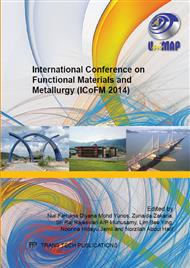[1]
M. Madzura, M. N. Mazlee, J. B. Shamsul, Sand Replacement Materials (SRM) in Sustainable Cement Composites; A concise review, Advanced Materials Research. 795 (2013), pp.91-95.
DOI: 10.4028/www.scientific.net/amr.795.91
Google Scholar
[2]
A. K. Sabat, A Study on Some Geotechnical Properties of Lime Stabilised Expansive Soil Quarry Dust Mixes, International Journal of Emerging Trends in Engineering and Development. 1 (2012), pp.42-49.
Google Scholar
[3]
Y. Divakar, S. Manjunath , M. U. Aswath , Experimental Investigation on Behaviour of Concrete with the use of Granite Fines, International Journal of Advanced Engineering Research and Studies. 1 (2012), pp.84-87.
Google Scholar
[4]
A. Sivakumar , M. Prakash , Characteristic Studies on the Mechanical Properties of Quarry Dust Addition in Conventional Concrete, Journal of Civil Engineering and Construction Technology. 2 (2011), pp.218-235.
Google Scholar
[5]
O. U. Joseph, E. E. Maurice, A. A. Godwin, Compressive strength of concrete using lateritic sand and quarry dust as fine aggregate, Journal of Engineering and Applied Sciences. 7 (2012) 81-91.
Google Scholar
[6]
T. K. Lohani, M. Padhi, K. P. Dash, S. Jena, Optimum utilization of quarry dust as partial replacement of sand in concrete, International Journal of Applied Sciences and Engineering Research. 1 (2012) 391-404.
DOI: 10.6088/ijaser.0020101040
Google Scholar
[7]
J. Manassa. Used of Crushed Granite Fine as Replacement to River Sand in Concrete, Leonardo Electronic Journal of Practices and Technologies ISSN 1583-1078. (2010), pp.85-96.
Google Scholar
[8]
R. K. Dhir, M. J. Carthy, Use of Conditioned PFA as Fine Aggregate Component in Concrete, J. Materials & Structures. 33 (2000), pp.38-42.
DOI: 10.1007/bf02481694
Google Scholar
[9]
R. Ilangovan, N. Mahendran, K. Nagamani, Strength and Durability Properties of Concrete Containing Quarry Rock Dust as Fine Aggregate, Journal of Engineering and Applied Sciences. 3 (2008), pp.20-26.
Google Scholar
[10]
T. Celik, K. Marar, Effects of Crushed Stone Dust on Some Properties of Concrete, Cement and Concrete Research. 26 (1996), pp.1121-1130.
DOI: 10.1016/0008-8846(96)00078-6
Google Scholar
[11]
B. S 1881: Part 116: (1983), Method for Determination of Compressive Strength of Concrete Cubes, Testing Concrete; British Standards Institution, London.
Google Scholar
[12]
M. O. Omar, D. A. E. Ghada, A. S. Mohamed, A. M. Hassan, Influence of Limestone Waste as Partial Replacement Material for Sand and Marble Powder in Concrete Properties, HBRC Journal. (2012), pp.193-203.
DOI: 10.1016/j.hbrcj.2012.10.005
Google Scholar
[13]
P. B. Sakthivel, C. Ramya, M. Raja, An Innovative Method of Replacing River Sand by Quarry Dust Waste in Concrete for Sustainability, International Journal of Scientific & Engineering Research. 4 (2013), pp.246-249.
Google Scholar
[14]
P. S. Anupama, M. Nazeer, A. Nizar, S. Suresh, Strength Studies on Metakaolin Modified Cement Mortar with Quarry Dust as Fine Aggregate, International Journal on Civil and Environmental Engineering. 1 (2011), pp.1-5.
Google Scholar
[15]
M. S. Hameed, A. S. S. Sekar, Properties of Green Concrete Containing Quarry Rock Dust and Marble Sludge Powder as Fine Aggregate, Journal of Engineering and Applied Sciences. 4 (2009), pp.83-89.
Google Scholar
[16]
J. P. Zhang, Strength of Cracked Concrete, Part 2: Micromechanical modelling of shear failure in cement paste and in concrete, Technical University of Denmark, Ph.D. (1997).
Google Scholar
[17]
T. F. Kala, Effect of Granite Powder on Strength Properties of Concrete, International Journal of Engineering and Science. 2 (2013), pp.36-50.
Google Scholar


